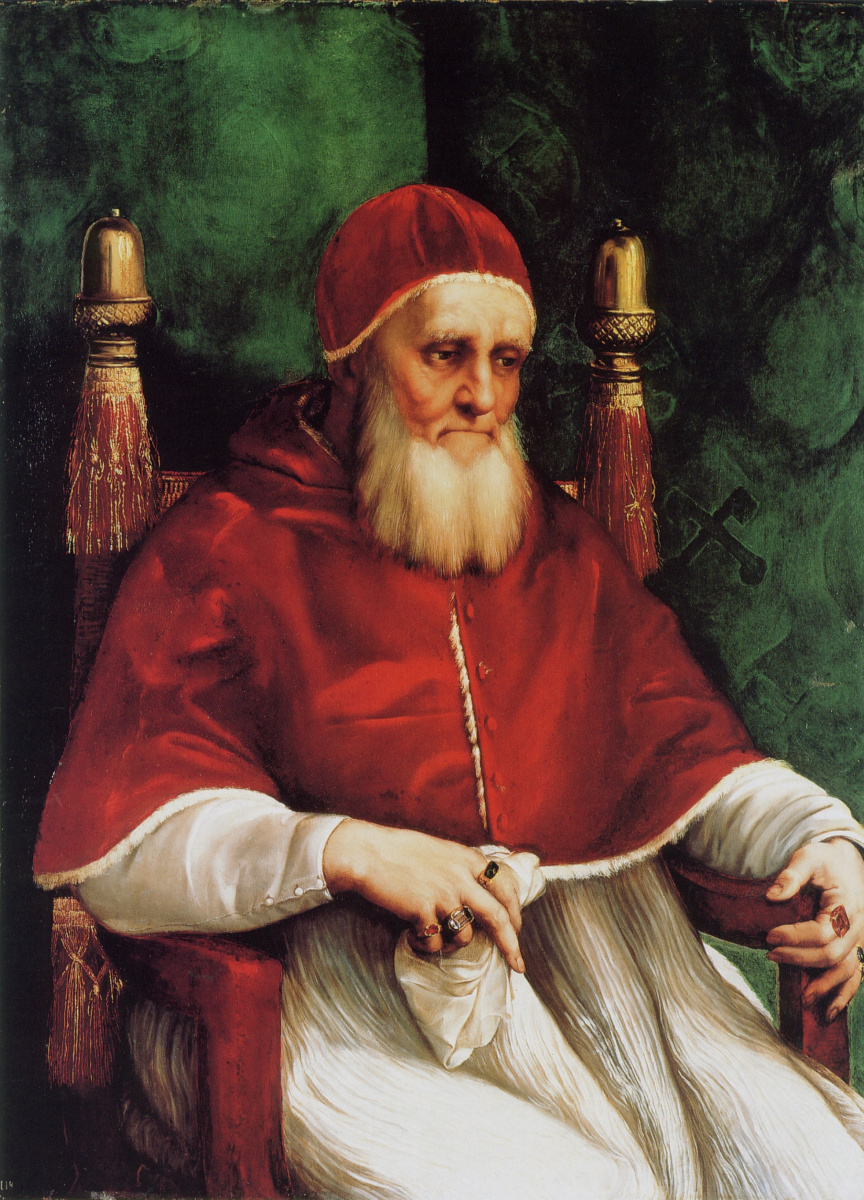log in
Enter site
Login to use Arthive functionality to the maximum
Portrait of Pope Julius II
Raphael Sanzio • Painting, 1512, 108.7×81 cm
Description of the artwork «Portrait of Pope Julius II»
Pope Julius II remained in history as the largest patron of the High Renaissance. It is to him that we owe the appearance of such masterpieces as St. Peter's Basilica, ceiling of the sistine chapelRaphael's frescoes inVatican stanzas (it. stanza - room).
What the future pope Julius II looked like in his youth can be seen onfresco another Italian artist -Melozzo da Forlì in the Vatican Museums, depicting seated Pope Sixtus IV, in the world of Francesco della Rover. Sixtus IV was sadly famous for his nepotism - he put nepotism on all key positions, i.e. their nephews and other relatives. Facing dad on the fresco da Forlì, a handsome handsome man in a red cassock is the nephew of Sixtus IV, Cardinal Giuliano della Rovere. In a few decades, he, like his uncle, will also become a dad, receiving the name Julius II.
In the portrait of Raphael, the aged Julius II looks like a model of Christian humility, his lips are tightly pressed, and his eyes are lowered with an expression of deep and restrained sadness. But this impression is misleading. Julius II had the image of the most warlike head of the Roman throne. It’s hard for us now to imagine how dad can lead the army, but Julius II did just that. The period of his pontificate was marked by endless wars. Rome clashed with Venice, then with France, expanding its borders. During this period, the papacy also claimed political rights to many regions of Italy (the Vatican would refuse them only in the 20th century). In some battles, Julius II took a personal part, carrying the Holy Gifts in front of him and inspiring exploits.
On the fresco da Forlì, the future Julius II is depicted without a beard (which allows the viewer to appreciate his strong-willed chin). But the white beard that Papa acquired in Rafael's portrait is not a tribute to age or position, as one might suppose. Julius II released his beard as a sign of mourning for Bologna, which he lost in a fierce battle. Such a detail as a beard helped the London National Gallery specialists to clarify the dating of the painting.
The young and still not famous Raphael was introduced to the pope by the architect of the Vatican Donato Bramante, and pretty soon Raphael became the favorite artist of Julius II.
Having ascended the Roman throne, Julius II first of all wished to get rid of everything that reminded of the past Pope Alexander VI (Rodrigo Borgia), who defiled Rome with licentiousness and corruption. One of Julius II's first orders was: “All portraits of Borgia should be covered with black crepe, all the tombs of Borgia should be opened, and their bodies sent back to where they came from - to Spain.” So that nothing reminds of the hated predecessor, the new pope decided to completely change the look of his palace. To do this, artists from all over the Apennines were called in who undertook to re-decorate the papal apartments. Among the invited masters for this work was Rafael.
The legend tells how one morning in the morning, Pope Julius II, waking up in a bad mood, examined what was done in the palace. Not without irritation he looked at everything that the invited masters had already managed to put on the walls. Much seemed to dad wrong and wrong. And suddenly he stopped in front of "Athens School", On which Raphael worked. The struck Julius II looked at it for a long time, and then ordered to bring down other frescoes from the walls and to expel all other artists. "And you, my beloved son, continue to work- He turned to Raphael. - I see only you understand what you are doing".
Another legend claims that when the warlike pope established the Swiss Guard, which was called to be responsible for the safety of the Vatican and the pope personally (greatly reduced in number, she continues to do so for five centuries now), Rafael developed a uniform for the soldiers.
The portrait of Julius II is striking in both technical and psychological perfection. Oil paints at that time were a relatively new technique for Italy, but Rafael was able to masterfully convey the difference in textures with their help - it is enough to compare the thin silk of the sleeve with the denser material of the folds located below. Fur, velvet, stones in the rings of the pope, thread brushes decorating the chair are also written wonderfully. By the way, the inverted acorns crowning them is a hint at the pope's secular surname and his character: della Rovere in Italian means "from oak."
Anna Yesterday


